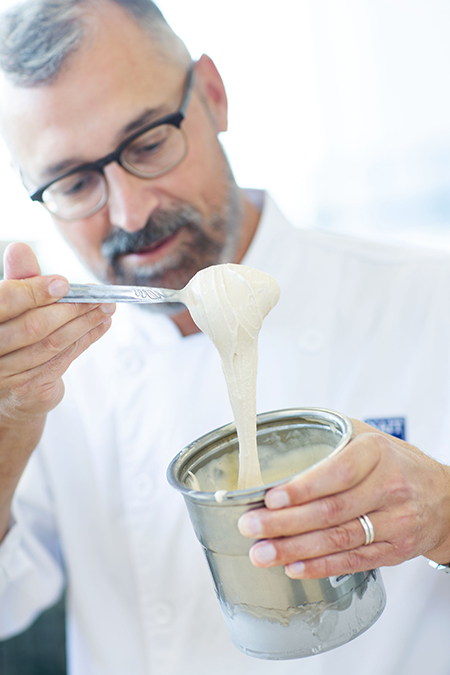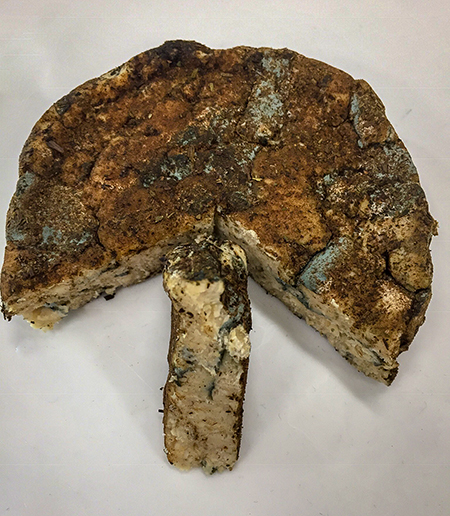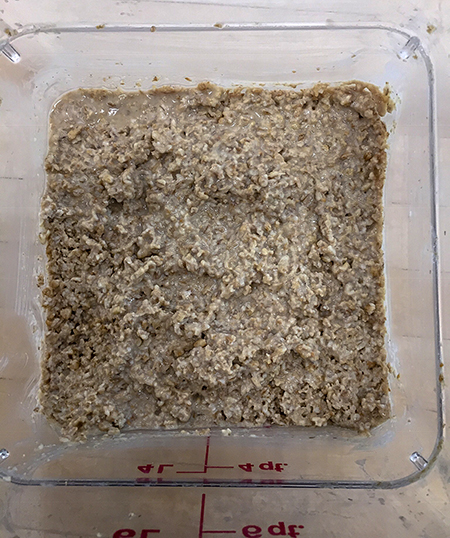Oat products fit health-conscious and gluten-free, vegan diets
If you ask NAIT research chef Maynard Kolskog (Cooking ’82), oats have a lot to offer the taste buds beyond a bland bowl of porridge.
Over the past several months, he has transformed the grain into oat milk and ice cream. By experimenting with fermentation, he’s created yogurt and even a version of miso, which is traditionally made with soybeans. He’s extruded dough into spiral pasta and employed probiotics and nutritional yeast to replicate the flavour profiles of cheeses such as Danish blue and a smoked gouda.
 With the latter, he even added an ash coating made from charred leeks.
With the latter, he even added an ash coating made from charred leeks.
“It’ll give it a nice finish but also a different dimension of flavour,” he says. “It almost looks like an expensive farm cheese.”
From NAIT’s research kitchen, Kolskog plays the role of mad oat scientist – experimenting with new concoctions and recipes with the grain. It’s part of a research partnership with the University of Alberta and the Prairie Oat Growers Association (POGA) to transform oats from humble cereal grain to myriad forms of heart-smart superfoods that fit a variety of consumer diets.
“I’m excited about utilizing the entire grain; it’s very reasonably priced and plus it’s an Alberta product,” says Kolskog.
Aiming for extraordinary
With any recipe, taste is everything. Can a hunk of fermented oat mash, yeast and probiotics really pass itself off as a creamy, salty-pungent blue cheese? Just like a science experiment, there’s a degree of trial and error and testing new hypotheses to prove a concept is fit for the human palate and plate.
“This isn’t Danish blue cheese, but with the right bacterial cultures we are able to get a passable facsimile, which is about the best you can do with any plant-based product,” Kolskog says.
Creating something tasty with ingredients that fall outside culinary norms is also what drives Kolskog, a former culinary instructor who introduced molecular gastronomy to the polytechnic. Now, he dedicates all his time to research. He’s part of NAIT’s new Centre for Culinary Innovation, which aims to help the ag sector and businesses become more competitive.
From his lab, he tests and retools recipes until they’re perfect. And he’s not afraid to take his work home, like the time he turned one of his meat substitutes into a vegan beef Wellington, which he served to his daughter over the holidays.
“That’s what I like about a lot of these projects. The challenge is to do quite extraordinary things with them. That’s what I love about the job.”
 The blue cheese, for example, isn’t perfect. The texture and mouthfeel is missing the characteristic creaminess of the real thing. But Kolskog is working toward a solution involving cold-pressed canola – another homegrown crop.
The blue cheese, for example, isn’t perfect. The texture and mouthfeel is missing the characteristic creaminess of the real thing. But Kolskog is working toward a solution involving cold-pressed canola – another homegrown crop.
“We’re looking at experimenting and doing things that haven’t been done before,” Kolskog says. “The potential is really amazing with this product.”
“That’s what I like about a lot of these projects. The challenge is to do quite extraordinary things with them.”
In addition to his work with oats, Kolskog has helped the U of A develop a healthier ice cream with lentil and barley. He’s also working with industry partners to turn pulses such as kidney beans, peas and white northern beans into soy- and gluten-free meat substitutes.
“They don’t necessarily have the means or the expertise to come up with palatable formulations and recipes, which is why they come to us – to be more innovative,” he says.
Transforming Canadian food and diets
Food scientist and project lead Dr. Lingyun Chen has worked with NAIT on several projects over the past five years, including that healthier ice cream. In that case, she developed a lentil protein but leveraged Kolskog’s expertise to transform it into something tasty.
“He can make food delicious,” she says, “so it’s complementary expertise.”
Kolskog’s oat experiments are part of a larger two-year project with Chen and the U of A to explore uses for fractionated oats, where the whole grain is separated into oat protein and fibre through dry milling. From her lab, Chen has developed an oat beverage milk substitute, which Kolskog has attempted to refine and transform into other products, including oat ice cream.
“NAIT can develop a palatable food, so it’s complementary expertise.”
The goal isn’t just about helping oat producers find new uses for their crop, it’s also about changing how Canadians eat, adds Chen. Oat has been shown to lower blood cholesterol and could help satisfy a growing appetite for plant-based food. Developing new oat products high in fibre and protein could help improve everything from Canadians’ weight management to heart health, she says.
“It’s another way we can change those valuable crops to a health food and improve public health.”
Oats fill a need for plant-based alternatives
Cheese made from oats, for example, offers a potential new alternative for consumers who can’t tolerate dairy or people interested in a plant-based or vegan diet. It could also appeal to those who don’t want soy, which is often grown with GMO seeds. Other options, such as cheeses made with cashews, aren’t cheap, are high in fat and aren’t grown locally, says Kolskog.
“We have lots of oats so this is something that’s indigenous to our agriculture already. It’s also very, very inexpensive.”
 Demand for plant protein overall could grow by 43% between 2010 and 2030 and exceed 150 million tonnes worldwide, based on some estimates. That interest could result in a near doubling of the plant protein market, growing from a USD$8.4 billion industry in 2016 to $14.2 billion in 2022.
Demand for plant protein overall could grow by 43% between 2010 and 2030 and exceed 150 million tonnes worldwide, based on some estimates. That interest could result in a near doubling of the plant protein market, growing from a USD$8.4 billion industry in 2016 to $14.2 billion in 2022.
“We have lots of oats so this is something that’s indigenous to our agriculture already. It’s also very, very inexpensive.”
Those are numbers that could get farmers salivating, including here in Alberta, which was the third-largest producer of oats in Canada last year after Saskatchewan and Manitoba. Prices are higher for producers than in previous years, says Shawna Mathieson, executive director with POGA, with value-added oat having the potential to improve producers’ return on investment.
Fractionation has the potential to tap into the health properties of oats for other food products. Oat fibre is high in beta glucan – a heart-healthy form of soluble dietary fibre – so foods with a lot of it, such as those developed by Kolkog, have a greater chance of finding favour with consumers in a growing market. Foods with at least 4% beta glucan can be labelled as “heart healthy” in the United States, where 90% of Canada’s oats exports end up, Mathieson says. Canada is the world’s biggest exporter of oats, shipping 2.5 million tonnes a year, so that’s not insignificant.
“To be able to have a high-fibre claim or a high-protein claim on something with oats, to be able to fractionate that out, has some real advantages,” she says.
A work in progress
Oat products such as milk substitutes have already found a spot on grocery store shelves, and the research partners see strong potential to expand. “There’s a lot of uses out there that haven’t been determined,” says Mathieson. “Canadians are hungry for more natural and healthy foods.”
Though Kolskog’s oat products aren’t quite ready for grocery store shelves, his progress is an important step in developing viable products.
In his research kitchen, he continues his oat experiments, most recently producing a pasta made with oat starch and protein and gluten-free flours. The texture is a bit softer than wheat pasta and there’s a slightly bitter after taste when eaten plain, but served with a marinara sauce and a healthy dusting of pecorino cheese, it’s not far off. But there’s still room for improvement.
“We want to get it where we have good flavours in it. Other than that, it’s a good noodle.”